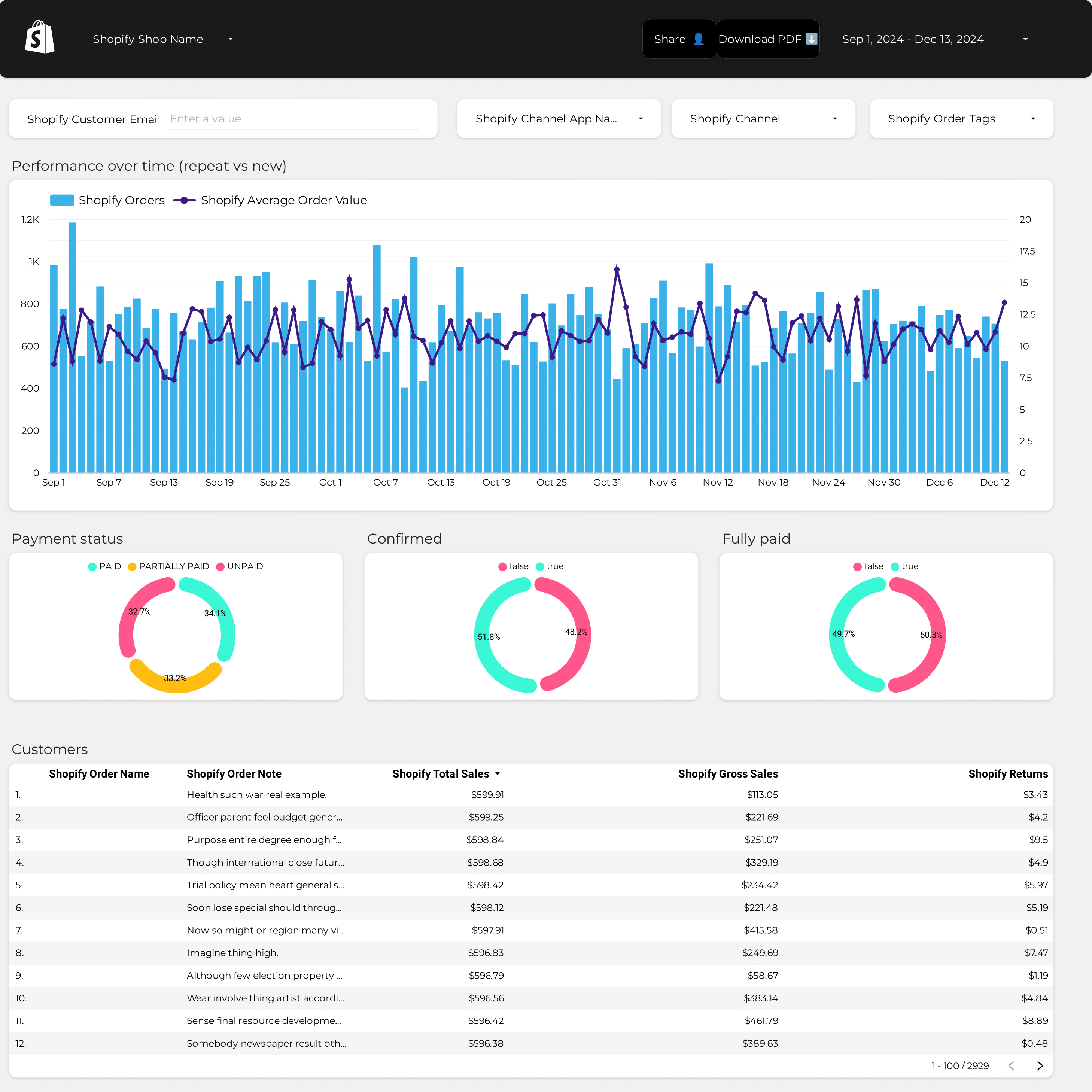
AOV Dashboard template
The AOV Dashboard Template is designed for e-commerce businesses using Shopify. This template provides a structured view of your Average Order Value (AOV) metrics, enabling data-driven decision-making.
Features include:
- Real-time Data Integration: Seamlessly connect with your Shopify store to access up-to-date AOV statistics.
- Customizable Widgets: Tailor the dashboard to display the most relevant AOV data for your business needs.
- Visual Analytics: Utilize charts and graphs to interpret AOV trends and patterns effectively.
This template is essential for monitoring and analyzing your store’s performance, providing insights into customer purchasing behavior and sales strategies.
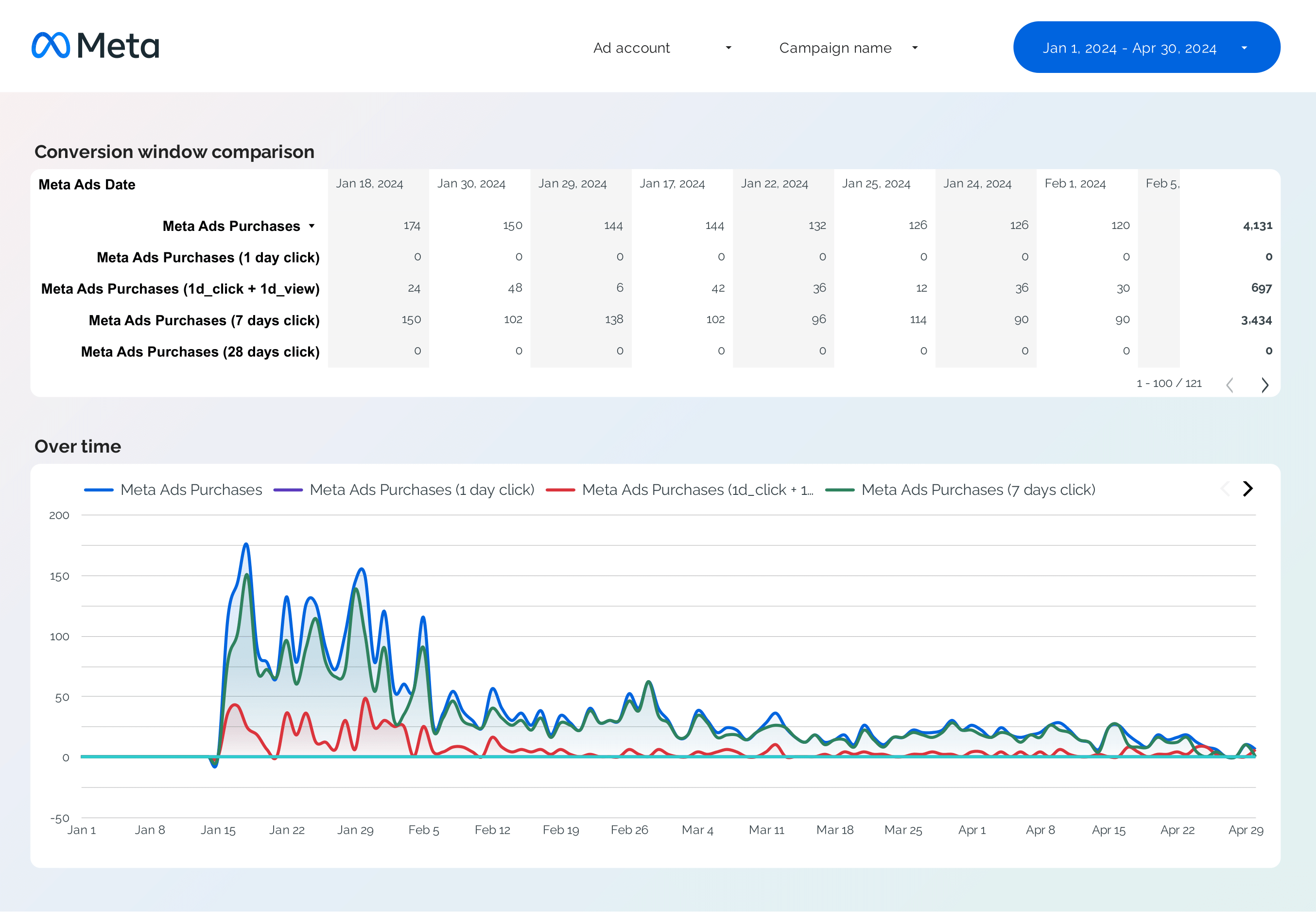
Facebook Ads Attribution Dashboard template
The Facebook Ads Attribution Dashboard template provides a structured view of your PPC campaigns performance. This tool is designed to help marketers understand the attribution of conversions across different touchpoints within Facebook Ads.
With this dashboard, you can:
- Track the performance metrics of your Facebook Ads campaigns.
- Analyze the conversion paths to identify which ads contribute to conversions.
- View multi-touch attribution data to understand the customer journey.
Utilize this template to gain insights into your advertising strategy and make informed decisions based on data-driven analysis.
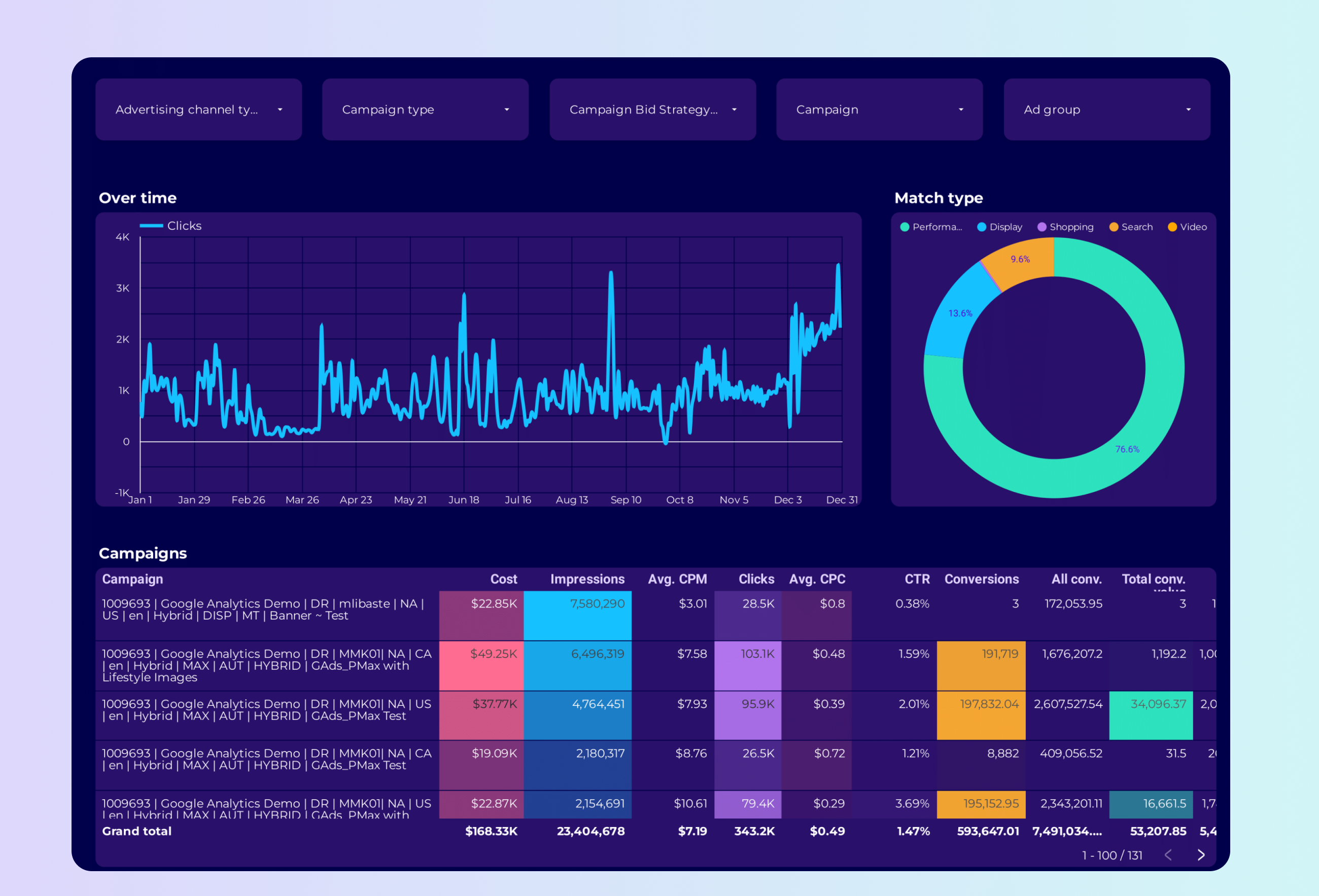
Google Ads PMax Dashboard template
The Google Ads PMax Dashboard template is designed for PPC professionals managing Google Ads campaigns. This template provides a structured view of your Performance Max campaigns, allowing for detailed analysis and reporting.
Features include:
- Campaign Performance Metrics: View metrics such as impressions, clicks, and conversions.
- Budget Tracking: Monitor daily and monthly spend to ensure alignment with campaign goals.
- Audience Insights: Analyze audience segments and their impact on campaign performance.
- Asset Performance: Evaluate the effectiveness of different creative assets within your campaigns.
This dashboard is essential for PPC managers looking to optimize their Google Ads strategies and achieve better results with Performance Max campaigns.
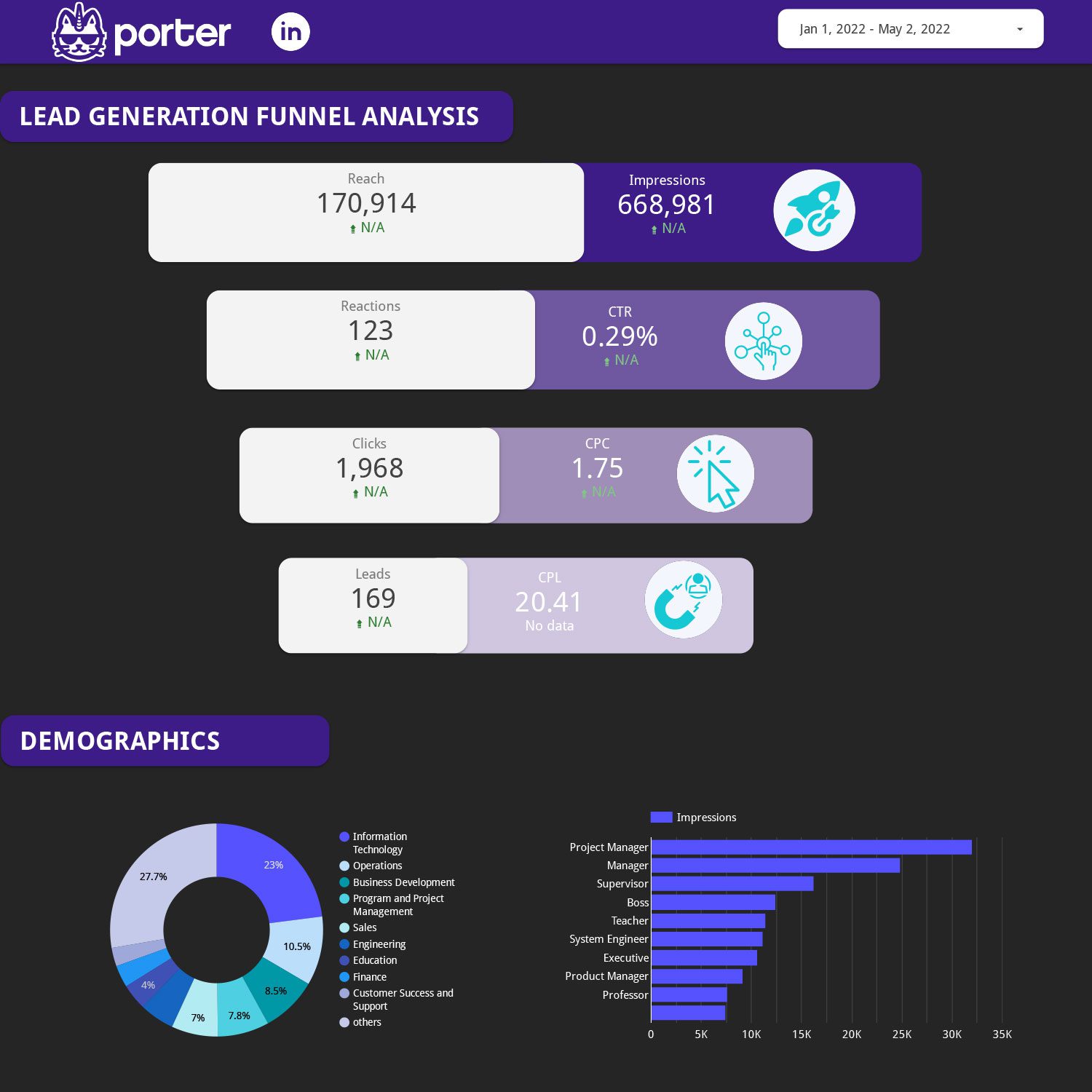
LinkedIn Ads Dashboard template
The LinkedIn Ads Dashboard Template is designed for professionals focused on PPC and Lead Generation in the B2B sector. This template provides a structured view of your Paid Media campaigns on LinkedIn, offering insights into performance metrics and audience engagement.
Key features include:
- Campaign Performance Metrics: Track impressions, clicks, and conversions to understand the effectiveness of your LinkedIn Ads.
- Audience Insights: Analyze demographic data to refine targeting strategies and improve lead quality.
- Budget Management: Monitor spend and ROI to optimize your advertising budget.
- Conversion Tracking: Measure lead generation success and identify high-performing campaigns.
This dashboard is essential for marketers aiming to maximize their LinkedIn Ads impact and drive business growth through targeted PPC strategies.
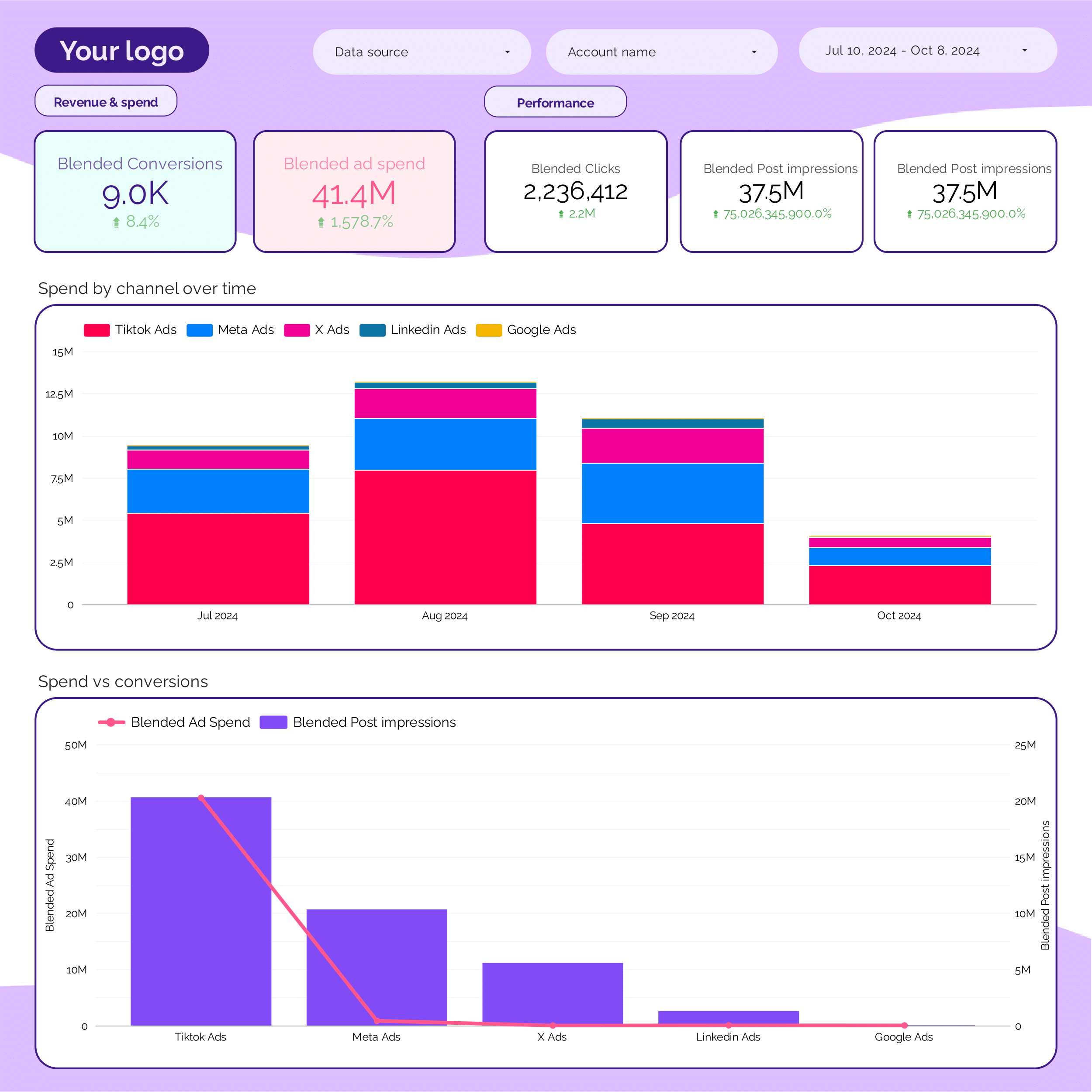
PPC monthly Dashboard template
The PPC Monthly Dashboard Template provides a structured overview of your advertising performance across multiple platforms. This template is designed to streamline the analysis of your campaigns on Facebook Ads, Google Ads, LinkedIn Ads, TikTok Ads, and Twitter Ads.
Each section of the dashboard focuses on specific metrics and data points relevant to each platform:
- Facebook Ads: Analyze metrics such as impressions, clicks, and conversion rates.
- Google Ads: Review data on cost-per-click (CPC), click-through rate (CTR), and quality score.
- LinkedIn Ads: Monitor engagement metrics, including sponsored content performance and lead generation.
- TikTok Ads: Evaluate video views, engagement rates, and audience demographics.
- Twitter Ads: Track tweet engagement, follower growth, and ad spend efficiency.
This template is updated monthly to provide a consistent view of your advertising efforts, allowing for data-driven decision-making and strategic planning.
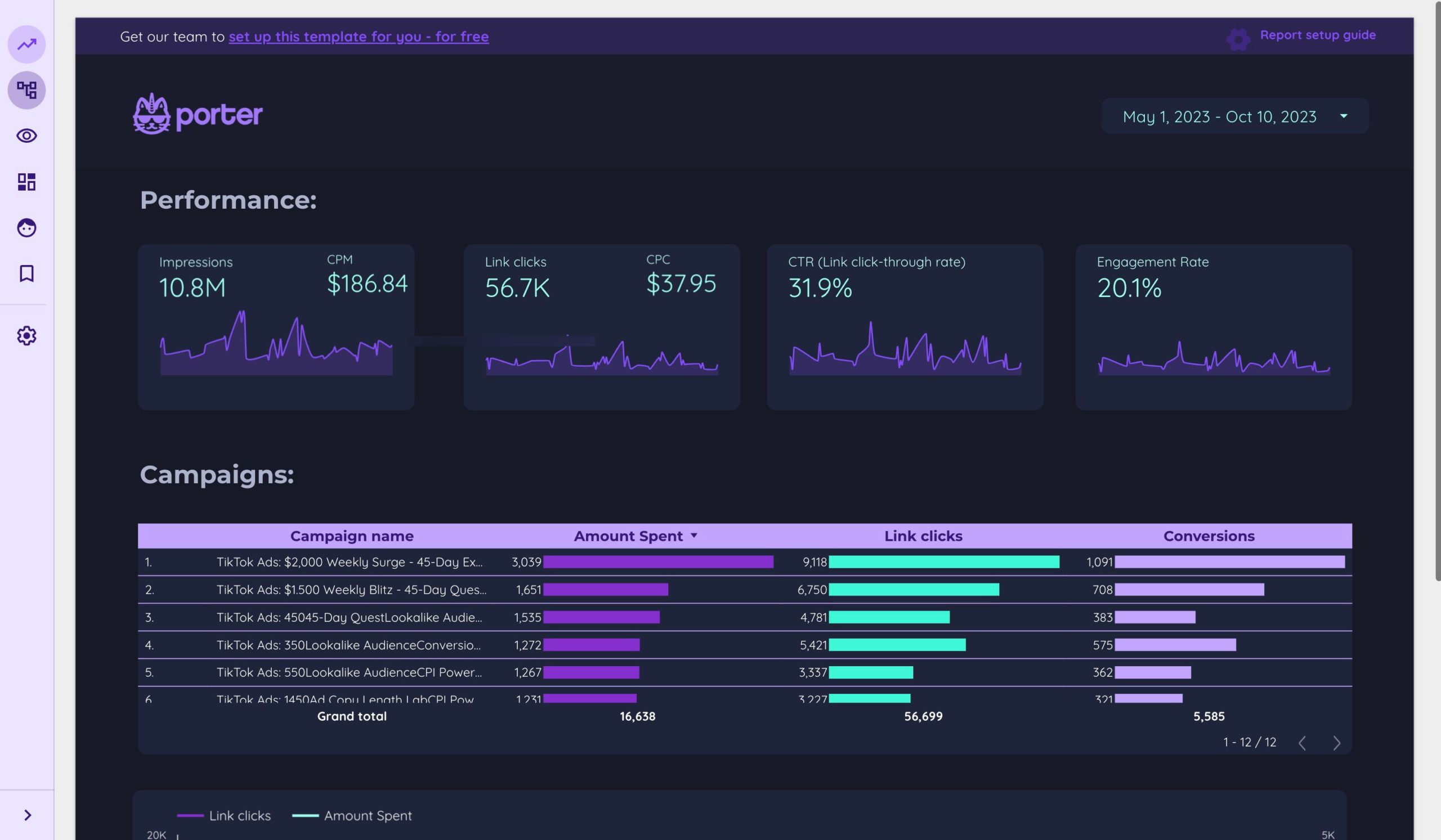
TikTok Ads Dashboard template
The TikTok Ads Dashboard Template is designed for PPC professionals managing TikTok advertising campaigns. This template provides a structured approach to monitor and analyze your ad performance effectively.
With this dashboard, you can:
- Track Ad Spend: Monitor your daily, weekly, and monthly ad expenditures to ensure budget adherence.
- Analyze Performance Metrics: Evaluate crucial metrics such as impressions, clicks, and conversions to assess campaign success.
- Visualize Data Trends: Utilize charts and graphs to identify patterns and make informed decisions.
- Optimize Campaigns: Use data insights to adjust targeting, creatives, and bidding strategies for improved results.
This template is an essential tool for PPC managers aiming to maximize their TikTok advertising efforts.

B2B Dashboard template
The B2B Dashboard template integrates with HubSpot, Facebook Ads, Google Ads, LinkedIn Ads, and Google Analytics 4 to provide a centralized view of your marketing and sales data.
Utilize this dashboard to track and analyze:
- CRM Data from HubSpot for lead management and sales performance.
- PPC Campaigns across Facebook, Google, and LinkedIn Ads to monitor ad spend and ROI.
- SEO Metrics to assess organic search performance and traffic sources.
- Website Analytics through Google Analytics 4 for user behavior insights and conversion tracking.
This template is designed for B2B marketers seeking to streamline data from multiple platforms into a single, actionable interface.

Facebook Ads Audience Dashboard template
The Facebook Ads Audience Dashboard template is designed for PPC professionals seeking to optimize their advertising strategies. This tool provides a structured overview of audience metrics, enabling data-driven decisions.
Features include:
- Demographic Insights: Analyze age, gender, and location data to tailor campaigns effectively.
- Engagement Metrics: Track interactions, clicks, and conversions to assess audience responsiveness.
- Custom Audience Segmentation: Create and manage audience segments for targeted advertising.
- Performance Tracking: Monitor ad performance across different audience groups to identify trends.
Utilize this dashboard to streamline your Facebook Ads campaigns and maximize ROI by focusing on audience-specific data.

Google Analytics 4 Dashboard template
The Google Analytics 4 Dashboard Template is designed for marketing professionals and e-commerce businesses seeking to leverage website data effectively. This template provides a structured view of your Google Analytics 4 data, focusing on essential metrics and insights.
With this dashboard, you can:
- Track user acquisition and understand which channels drive the most traffic.
- Analyze user behavior to identify popular pages and content.
- Monitor conversion rates to assess the performance of marketing campaigns.
- Evaluate e-commerce metrics such as revenue, average order value, and product performance.
This template is tailored for those who need to make data-driven decisions based on real-time analytics and customizable reports.

LinkedIn Ads Dashboard template
The LinkedIn Ads Dashboard Template is designed for PPC specialists and B2B SaaS companies focusing on lead generation through LinkedIn Ads. This template provides a structured view of your advertising performance, enabling data-driven decisions.
Features include:
- Campaign Performance Metrics: Track impressions, clicks, and conversions to understand campaign effectiveness.
- Audience Insights: Analyze demographic data to refine targeting strategies.
- Budget Management: Monitor spend and ROI to optimize ad spend.
- Lead Generation Tracking: Measure the quality and quantity of leads generated.
This dashboard is essential for marketers aiming to maximize their LinkedIn Ads strategy and achieve measurable results in the B2B sector.

PPC multi-channel Dashboard template
The PPC Multi-Channel Dashboard Template is designed for marketers managing campaigns across various platforms. This template integrates data from TikTok Ads, Facebook Ads, Google Ads, Twitter Ads, and LinkedIn Ads.
With this dashboard, users can:
- Track performance metrics across all channels in one place.
- Analyze campaign data to identify trends and patterns.
- Compare ad spend and ROI across different platforms.
- Monitor audience engagement and conversion rates.
This template supports data-driven decision-making by providing a unified view of multi-channel PPC efforts.

Twitter Ads Dashboard template
The Twitter Ads Dashboard Template is designed for PPC professionals seeking to streamline their advertising efforts on X Ads. This template provides a structured approach to managing and analyzing Twitter Ads campaigns.
With this dashboard, you can:
- Track campaign performance with real-time data updates.
- Monitor ad spend and compare it against budget allocations.
- Analyze audience engagement metrics to optimize targeting strategies.
- Visualize conversion rates and assess the effectiveness of ad creatives.
Utilize this template to maintain a clear overview of your Twitter Ads campaigns, ensuring data-driven decisions and maximizing ROI.
